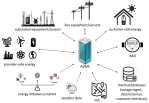Electric utility companies around the world have reached a critical juncture. To ensure continued and efficient power supply to their customers they must adapt to fundamental demands that the energy transition and ongoing electrification are exerting on their grids. Electric grid modernization is the key to utilities’ futures.
The demand for electricity is growing at an ever-increasing pace due consumer and technology changes. In the article AI Is Pushing The World Toward An Energy Crisis, Forbes wrote “GPT-4, for example, required over 50 gigawatt-hours, approximately 0.02% of the electricity California generates in a year, and 50 times the amount it took to train GPT-3, the previous iteration.” Other key contributors to electricity demand include the adoption of electric vehicles (EVs) coupled with the charging infrastructure to support them; heat pumps, both residential and commercial; and AI and cryptocurrency demands from data centers.
Net zero and ESG policies dictate that low carbon, renewables generation must increase to meet this demand. Investment in distributed energy resources (DERs) such as wind and photovoltaic farms are being commissioned faster than ever, with the EU investing trillions of Euros to bring new renewable resources online.
This presents a significant challenge for electric grid companies.

Need for electric grid modernization
Traditional electric grids were designed for a one-way flow of power from generation sources (power plants) to consumers (residential and commercial). Renewable energy sources like solar have bidirectional needs. The share of renewables in the global power generation mix is forecast to rise from 29% in 2022 to 35% in 2025 according to the International Energy Agency 2023 report. As DERs become more prevalent, the power-flow direction is shifting towards a multi-directional mesh-like flow, creating new challenges:
- Rigid physical infrastructure: Current devices in substations are often black-box physical appliances with tightly coupled hardware and software that are physically wired together. This makes it difficult to modernize or upgrade without replacing the entire physical device, or in some cases an entire system.
- Inefficient resource utilization: Traditional physical devices in substations such as centralized protection and control devices, for example intelligent electronic devices (IEDs), are designed for specific tasks. They do not fully utilize available resources such as CPU and memory, limiting the substation’s potential. This also leads to increased inventory management, which in turn occupies more space.
- Grid management and control: The increased complexity of the grid requires advanced distribution management systems (ADMS) for reliable and efficient operations.
- Power quality and reliability: As DERs are incorporated, the power quality is expected to fluctuate. The grid must adapt to this varying power output.
- Cybersecurity: Increased sources of energy and complexity in the grid create new cybersecurity risks, thus making it more vulnerable.
- Lack of data collection: Substations generate huge amounts of data that can be used for analytics and applications such as grid balancing and AI/ML model training for improving the grid performance and efficiency. However, with current designs, most of the data is lost and not analyzed at the edge.
- Lack of IT skill set: While IT staff are available at data centers, each substation may not have their own dedicated IT personnel available to deploy and manage applications at the substations. Having a consistent environment across substations with the ability to manage them from a centralized location becomes paramount.
- Physical constraints: Substations have a pre-defined area within which they need to deploy all their infrastructure, while ensuring proper security and cooling mechanisms are in place. This makes it more difficult to scale at the substation level to increase output using the same physical infrastructure.
- Edge hardware and protocol support: The electric utilities industry is heavily regulated and requires strong compliance with industry standards such as IEC 61850. This limits the options electric utilities are left with when deploying substations.
The solution: VMware Edge Compute Stack
To address these challenges, electric utility companies need to modernize their grids. VMware Edge Compute Stack is a purpose-built edge compute and orchestration platform designed to operate and manage workloads at power distribution and generation sites. Edge Compute Stack accelerates this journey by providing a flexible infrastructure, efficient resource management, simplified grid control and management, and data analytics ability.

Figure 2: VMware Edge Compute Stack architecture
Benefits of VMware Edge Compute Stack
- Virtualization: Substations today use physical protection and control devices with tightly coupled hardware and software. Because each physical device performs a single function and does not fully utilize the physical resources available, moving to a virtualization-based platform that can support both VMs and containers such as VMware Edge Compute Stack provides electric utilities with multiple advantages. These include simplified space and inventory management, improved physical resource usage, agility and flexibility in application deployment and updates, and avoiding vendor lock-in.
- Orchestration: Edge Compute Stack using VMware Edge Cloud Orchestrator (VECO) allows easy management and scaling of thousands of substations from a single pane of glass for Day-0 operations such as deploying new applications, and Day 2 operations such as updating existing applications or monitoring and troubleshooting any issues.
- Analytics: The Edge Compute Stack platform allows data collection at the edge and the ability to run data analytics applications at the edge, to avoid the overhead of sending data back to the data center.
- Reduced CapEx and OpEx: Edge Compute Stack reduces the number of physical devices required to perform the same set of tasks at the substation, resulting in cost savings.
- Autonomous operations: Substations need to operate in remote locations, and continue operations even in disconnected or low network connectivity environments. Edge Compute Stack can run applications in disconnected environments, making it ideal for substations.
Addressing the challenges of electric grid modernization
VMware Edge Compute Stack helps address the challenges of electric grid modernization.
- Flexible infrastructure: Virtualizing physical functions running on stand-alone boxes in the substation to virtual machines or containers opens a new realm of possibilities for the substation to manage their applications and turn them into a software-defined grid.
- Efficient resource management: Multiple functions can run on the same commercial off-the-shelf (COTS) hardware for maximum resource utilization. This drastically reduces the physical space and number of devices required at the substation.
- Grid management and control: VMware Edge Compute Stack comes with the VMware Edge Cloud Orchestrator management UI, which acts as a single pane of glass for deploying and managing thousands of edge devices and substations.
- Power quality and reliability: Edge Compute Stack can monitor power quality at the edge and send alerts in case of fluctuations. Other control applications running on the same device can be deployed to control the power flow and stop the power flow if needed.
- Cybersecurity: Edge Compute Stack is designed with security at the center, incorporating security elements such as secure boot, encryption of data, network segmentation, monitoring and logging. On top of this, cyber security applications can be deployed on the edge device to address specific utilities’ concerns.
- Data analytics: With GPU support, Edge Compute Stack can run edge AI applications such as fault prediction and prevention at the substation by analyzing data in real-time and using AI/ML applications to predict faults and take corrective actions in real-time.
- OT Operations: With zero-touch deployment at the substation, IT staff does not need to be on site each time a new device is installed or an existing one replaced.
- Optimal resource allocation: Because virtualization allows multiple applications to be hosted on the same physical infrastructure, the number of devices required to host the same set of applications decreases when compared to a non-virtualized infrastructure. This helps solve the fixed substation size constraint.
- Edge hardware and protocol support: Edge Compute Stack adheres to the requirements of the IEC 61850 standards such as support for sampled values (SV), GOOSE, MMS, PTP and PRP protocols, among others.
Conclusion
As the electric grid continues to evolve, it is essential for electric utility companies to modernize their grids to meet the challenges and opportunities ahead. VMware Edge Compute Stack is a key solution for this modernization, providing a flexible, efficient, and scalable infrastructure for the grid of the future.
Meet with us at Enlit Europe
The VMware team will be at Enlit Europe, 22-24 October 2024 Hall 5, meeting room 5MR13. Visit us there or email us.







